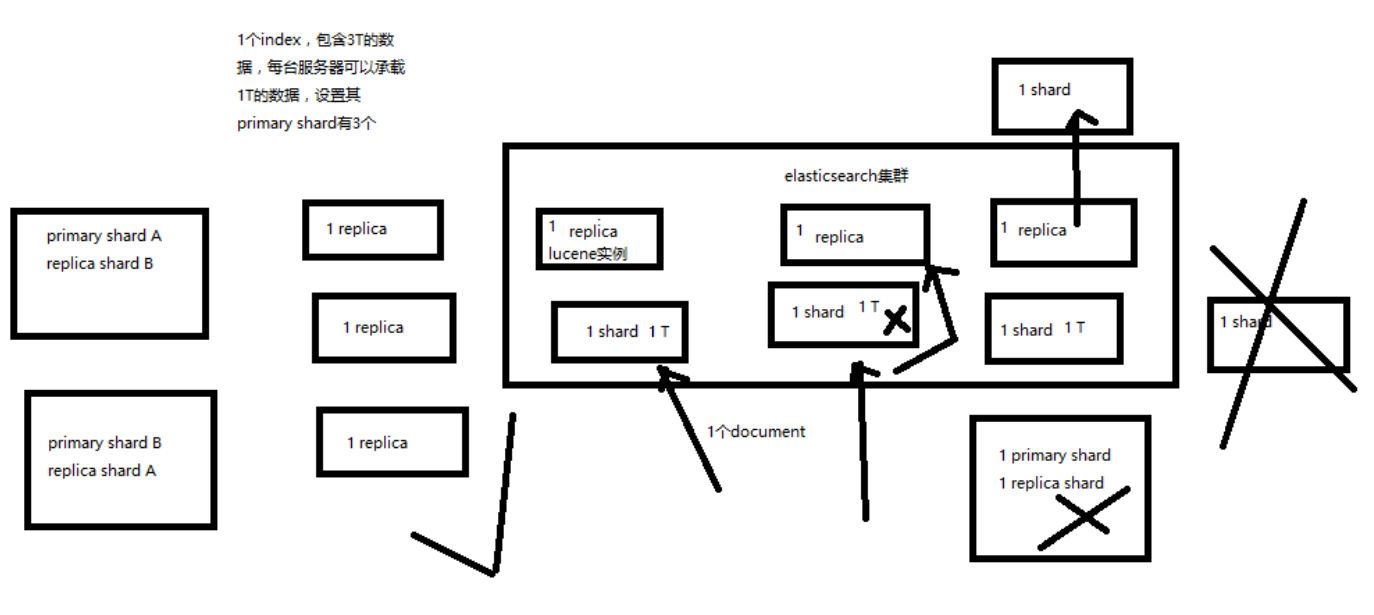# 单节点 shard & replica 机制
- shard & replica 机制再次梳理
- 图解单 node 环境下创建 index 是什么样子的
# shard & replica 机制再次梳理
- index 包含多个 shard
- 每个 shard 都是一个最小工作单元,承载部分数据,是一个 lucene 实例,完整的建立索引和处理请求的能力
- 增减节点时,shard 会自动在 nodes 中负载均衡
- primary shard 和 replica shard,每个 document 肯定只存在于某一个 primary shard 以及其对应的 replica shard 中,不可能存在于多个 primary shard
- replica shard 是 primary shard 的副本,负责容错,以及承担读请求负载
- primary shard 的数量在创建索引的时候就固定了,replica shard 的数量可以随时修改
- primary shard 的默认数量是 5,replica 默认是 1,默认有 10个 shard,5个 primary shard,5个 replica shard
- primary shard 不能和自己的 replica shard 放在同一个节点上(否则节点宕机,primary shard 和副本都丢失,起不到容错的作用),但是可以和其他 primary shard 的 replica shard 放在同一个节点上
对于 shard 和 replica 的总结:
- pri : primary shard
- rep : replica shard
- 所以一个 es 实例叫做 shard
- rep 的配置是针对于每个 pri 的副本个数
如:test 的 pri=2,rep=2;那么将产生 2个 primary shard 和 4个 replica shard

# 图解单 node 环境下创建 index 是什么样子的
- 单 node 环境下,创建一个 index,有 3个 primary shard,3个 replica shard
- 集群 status 是 yellow
- 这个时候,只会将 3个 primary shard 分配到仅有的一个 node 上去,另外 3个 replica shard 是无法分配的
- 集群可以正常工作,但是一旦出现节点宕机,数据全部丢失,而且集群不可用,无法承接任何请求
PUT /test_index
{
"settings": {
"number_of_shards": 3,
"number_of_replicas": 1
}
}
1
2
3
4
5
6
7
2
3
4
5
6
7
GET /_cat/health?v
epoch timestamp cluster status node.total node.data shards pri relo init unassign pending_tasks max_task_wait_time active_shards_percent
1546323256 14:14:16 elasticsearch yellow 1 1 9 9 0 0 9 0 - 50.0%
1
2
3
4
2
3
4
GET /_cat/indices?v
health status index uuid pri rep docs.count docs.deleted store.size pri.store.size
yellow open ecommerce ZpGp7bIBQBaZFk9SYmbJVQ 5 1 4 0 22.2kb 22.2kb
yellow open test_index g4RJx2v8TXK95LdwlhRx5A 3 1 0 0 390b 390b
yellow open .kibana id1SV_oGSjyGosKxeJApww 1 1 1 0 3.1kb 3.1kb
1
2
3
4
5
6
2
3
4
5
6
来计算下是否是正确的:这个单节点集群有 9个 shards ,9个 pri,有 9个 unassign;
再来统计下这 3个 索引一共有 9个 pri,每个索引都有 1个 rep,那么一共会产生 9个 rep。 9个 unassign 全是这 9个 rep,因为 同一份数据的 pri 和 rep 不能在一台机器上;
也就是说,一共会产生 18 个 shard;这里只有 9个,还有 9个没有被分配
而 pri 的数据却可以再同一台机器上,这里创建的 3个 pri 都会在这个 node 上存在